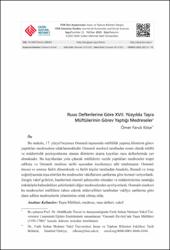| dc.contributor.author | Köse, Ömer Faruk | |
| dc.date.accessioned | 2023-12-26T08:18:29Z | |
| dc.date.available | 2023-12-26T08:18:29Z | |
| dc.date.issued | 2023 | en_US |
| dc.identifier.citation | KÖSE, Ömer Faruk. "Ruus Defterlerine Göre XVII. Yüzyılda Taşra Müftülerinin Görev Yaptığı Medreseler". FSM İlmî Araştırmalar İnsan ve Toplum Bilimleri Dergisi, 22 (2023): 81-118. | en_US |
| dc.identifier.uri | https://dergipark.org.tr/tr/pub/fsmia/issue/81557/1408455 | |
| dc.identifier.uri | https://hdl.handle.net/11352/4695 | |
| dc.description.abstract | Bu makale, 17. yüzyıl boyunca Osmanlı taşrasında müftülük yapmış âlimlerin görev
yaptıkları medreselere odaklanmaktadır. Osmanlı merkezi tarafından resmi olarak müftü
ve müderrislik pozisyonlarına atanan âlimlerin atama kayıtları ruus defterlerinde yer
almaktadır. Bu kayıtlardan yola çıkarak müftülerin vazife yaptıkları medreseler tespit
edilmiş ve Osmanlı medrese tarihi açısından incelemeye tabi tutulmuştur. Osmanlı
öncesi ve sonrası farklı dönemlerde ve farklı kişiler tarafından Anadolu, Rumeli ve Arap
coğrafyasında inşa ettirilen bu medreseler vâkıflarının şartlarına göre hizmet veriyorlardı.
Zengin vakıf gelirleri, banilerinin önemli şahsiyetler olmaları ve müderrislerine sunduğu
imkânlarla bulundukları şehirlerdeki diğer medreselerden ayrılıyorlardı. Osmanlı merkezi
bu medreseleri müftülere tahsis ederek mütevellileri tarafından vakfiye şartlarına göre
idare edilen medreselerin yönetimine ortak olmuş oldu. | en_US |
| dc.description.abstract | This article focuses on the madrasas, where scholars served as mufti in the Ottoman
province during the 17th century. The appointment records of the scholars who were
officially appointed to the positions of mufti and mudarris by the Ottoman center are
included in the ruus registers. Based on these records, the madrasas where muftis served
were determined and examined in terms of Ottoman madrasa history. These madrasas,
built by different people in different periods in Anatolia, Rumelia, and Arabian geography
before and after the Ottoman Empire, served according to the conditions of their
foundations. They were distinguished from other madrasas in the cities with their rich
foundation income, their benefactors being essential personalities, and the opportunities
they offered to their professors. By allocating these madrasas to muftis, the Ottoman
center became a partner in managing them, which their trustees administered according
to the endowment conditions. | en_US |
| dc.language.iso | tur | en_US |
| dc.publisher | FSM Vakıf Üniversitesi | en_US |
| dc.relation.isversionof | 10.16947/fsmia.1408455 | en_US |
| dc.rights | info:eu-repo/semantics/openAccess | en_US |
| dc.subject | Taşra Müftüsü | en_US |
| dc.subject | Medrese | en_US |
| dc.subject | Ruus Defteri | en_US |
| dc.subject | Vakıf | en_US |
| dc.subject | Provincial Mufti | en_US |
| dc.subject | Madrasa | en_US |
| dc.subject | Ruus Register | en_US |
| dc.subject | Foundation | en_US |
| dc.title | Ruus Defterlerine Göre XVII. Yüzyılda Taşra Müftülerinin Görev Yaptığı Medreseler | en_US |
| dc.title.alternative | Madrasas Served by Provincial Muftis According to the Ruus Registers in the XVII. Century | en_US |
| dc.type | article | en_US |
| dc.relation.journal | FSM İlmî Araştırmalar İnsan ve Toplum Bilimleri Dergisi | en_US |
| dc.contributor.department | FSM Vakıf Üniversitesi, Rektörlük, FSM İlmî Araştırmalar İnsan ve Toplum Bilimleri Dergisi | en_US |
| dc.contributor.authorID | https://orcid.org/0000-0001-8606-6104 | en_US |
| dc.identifier.issue | 22 | en_US |
| dc.identifier.startpage | 81 | en_US |
| dc.identifier.endpage | 118 | en_US |
| dc.relation.publicationcategory | Makale - Ulusal Hakemli Dergi - Kurum Öğretim Elemanı | en_US |
| dc.contributor.institutionauthor | Köse, Ömer Faruk | |



















